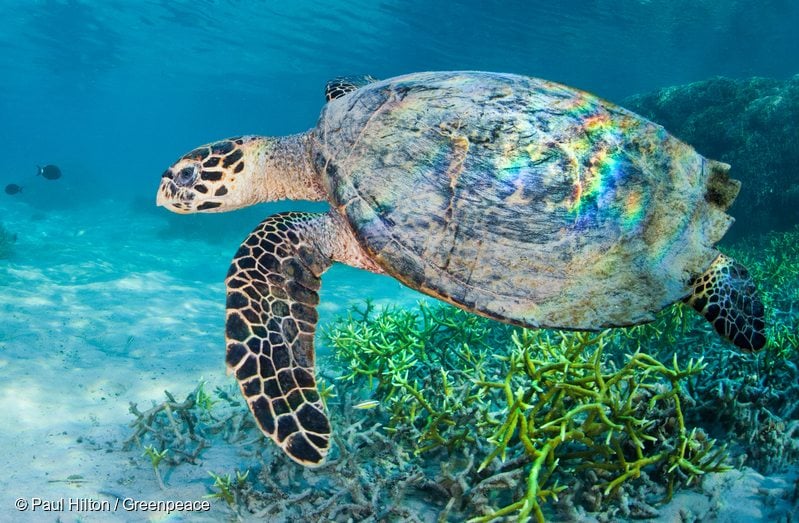7 species of sea turtle are recognized worldwide, including:
- The loggerhead (Caretta caretta);
- Green turtle (Chelonia mydas);
- Leatherback (Dermochelys coriacea);
- Hawksbill (Eretmochelys imbricata);
- Kemp’s ridley (Lepidochelys kempii);
- Olive ridley (Lepidochelys olivacea);
- Flatback (Natator depressa)
All species but the flatback is listed as either endangered or threatened under the Endangered Species Act.
Population status and distribution:
Nesting females provide general population estimates. The total number of nesting females for the leatherback is < 35,000 ; the green turtle is 88,520; the loggerhead is 44,560; the hawksbill is 22,900; the Kemp’s ridley is >2,500; the olive ridley is 800,000; and the flatback is 20,285.
Ways to identify 3 U.S. species:
Green: Adults are medium to large turtles ranging in size from 36-43 inches and weighing from 200-300 pounds. They are brownish in color with a radiating pattern of markings on the shell.
Hawksbill: Named for their hawk-like beak, adult hawksbills are small to medium sized ranging 30-36 inches and weighing from 100-200 pounds. They have a beautiful shell with thick overlapping scales providing the source of tortoise shell jewelry and products.
Loggerhead: These turtles are named for their disproportionately large head. They are large turtles ranging in size from 33-40 inches and weighing between 150-400 pounds. The shell of the loggerhead is reddish-brown.
Biology
Sea turtles have existed since before the time of the dinosaurs (150 million years ago), and some species such as the leatherback have remained virtually unchanged for over 90 million years.
Sea turtles do not have teeth but their powerful jaws enable them to feed on various types of food.
The hawksbill turtle dwells in tropical reefs and feeds primarily on sponges. The loggerhead is also found around reefs, but frequents wrecks and underwater structures feeding on crabs, jellyfish, and mollusks. The green turtle is primarily a tropical herbivorous species, feeding mainly on sea grasses.
Sea turtles hatch from eggs laid on land. Nesting is the only time that female sea turtles return to land and males never return once hatched. Females often return to the same beach that they were hatched to lay their eggs.
Sea turtles migrate very long distances to nest and feed.
Although impossible to determine a sea turtle’s age by appearance, it is thought that some sea turtles can live to exceed 100 years.
Threats
The greatest causes for green sea turtle population decline have been the commercial harvest for eggs and meat, and poaching for leather and jewelry. By-catch in shrimp trawlers has increasingly led to green sea turtle mortality.
Commercial exploitation for hawksbill shell in addition to leather, oil, perfume and cosmetics contribute to this species’ decline. Hawksbill eggs are also harvested for consumption.
Loggerhead populations are mainly threatened by coastal development, commercial fisheries, and pollution. This species is also often killed by shrimp trawlers.
Generally, human activity is the major threat to sea turtles worldwide. Capture in gillnets and other fishing gear, trawls, traps, and longlines; harvesting; habitat destruction; and ocean pollution, all inhibit conservation efforts. Disease, affecting certain species in some areas of the world, naturally threatens sea turtle populations

